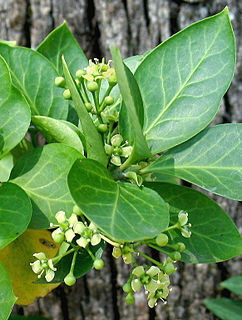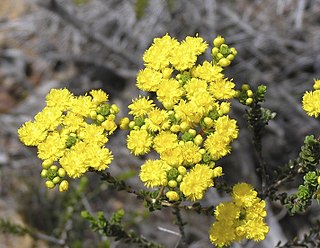
Teak is a tropical hardwood tree species in the family Lamiaceae. It is a large, deciduous tree that occurs in mixed hardwood forests. Tectona grandis has small, fragrant white flowers arranged in dense clusters (panicles) at the end of the branches. These flowers contain both types of reproductive organs. The large, papery leaves of teak trees are often hairy on the lower surface. Teak wood has a leather-like smell when it is freshly milled and is particularly valued for its durability and water resistance. The wood is used for boat building, exterior construction, veneer, furniture, carving, turnings, and other small wood projects.

Engelhardia is a genus of seven species of trees in the family Juglandaceae, native to southeast Asia from northern India east to Taiwan, Indonesia and the Philippines. The genus name is commonly misspelled "Engelhardtia", a "correction" made by the original author Carl Ludwig Blume in 1829 and persistent until today, as it was thus entered in the Index Kewensis; the original spelling is Engelhardia.

Lansium parasiticum, commonly known as langsat, lanzones, or longkang in English; duku in Indonesian or dokong in Terengganu Malay, is a species of tree in the Mahogany family with commercially cultivated edible fruits. The species is native to Southeast Asia.

Banksia serrata, commonly known as the saw banksia, the old man banksia, the saw-tooth banksia or the red honeysuckle and as wiriyagan by the Cadigal people, is a species of woody shrub or tree of the genus Banksia, in the family Proteaceae. Native to the east coast of Australia, it is found from Queensland to Victoria with outlying populations on Tasmania and Flinders Island. Commonly growing as a gnarled tree up to 16 m (50 ft) in height, it can be much smaller in more exposed areas. This Banksia species has wrinkled grey bark, shiny dark green serrated leaves and large yellow or greyish-yellow flower spikes appearing over summer. The flower spikes, or inflorescences, turn grey as they age and pollinated flowers develop into large, grey, woody seed pods called follicles.

Euonymus fortunei, the spindle, Fortune's spindle, winter creeper or wintercreeper, is a species of flowering plant in the family Celastraceae, native to east Asia, including China, Korea, the Philippines and Japan. It is named after the Scottish botanist and plant explorer Robert Fortune. Euonymus is highly invasive and damaging in the United States, causing the death of trees and forest in urban areas.
Banksia densa is a species of column-like shrub that is endemic to Western Australia. It has deeply serrated to pinnatifid leaves, creamy yellow flowers in heads of up to seventy-five, and hairy follicles.

Correa lawrenceana, commonly known as mountain correa, is a species of shrub or small tree of the family Rutaceae and is endemic to Australia. It has elliptical to egg-shaped leaves arranged in opposite pairs and cylindrical, greenish yellow to red flowers usually arranged singly or in groups of up to seven in leaf axils with the stamens protruding beyond the end of the corolla.

Campylospermum serratum is a plant in the family Ochnaceae. The specific epithet serratum is from the Latin meaning "with teeth", referring to the leaf margin. It is found in Tropical Asia, from Sulawesi, Indonesia to Hainan, Zhōngguó/China and over to southwester India. Gomphia serrata was a previous common name for the species. The plant is used for it wood and its sap is used in folk medicine and in the past for teeth-blackening.

Cinnamomum iners is a tree species in the family Lauraceae described by Reinwardt and Blume. No subspecies are listed in the Catalogue of Life. It occurs naturally in Sri Lanka, India, Bangladesh, Myanmar, Thailand, Laos, Cambodia, Vietnam, Malaysia, Indonesia, the Philippines and southern China and south-eastern Tibet.

Leptospermum turbinatum, commonly known as shiny tea-tree, is a species of spreading shrub that is endemic to the Grampians and nearby ranges in Victoria, Australia. It has thin, rough bark, elliptical to lance-shaped leaves with the narrower end towards the base, relatively large white flowers and fruit that remains on the plant at maturity.

Persoonia myrtilloides, commonly known as myrtle geebung, is a plant in the family Proteaceae and is endemic to New South Wales. It is an erect to spreading shrub with elliptic to egg-shaped leaves and yellow flowers in groups of up to forty on a rachis up to 170 mm (6.7 in) long.
The micrantha is a wild citrus from the papeda group, native to southern Philippines, particularly islands of Cebu and Bohol. Two varieties are recognized: small-flowered papeda, locally known as biasong, and small-fruited papeda or samuyao.

Verticordia serrata is a flowering plant in the myrtle family, Myrtaceae and is endemic to the south-west of Western Australia. It is a spindly or openly branched shrub with hairy, egg-shaped leaves and flowers which are golden at first, then fade to a greyish colour.
Xerospermum noronhianum is a common Asian tree species described by Carl Ludwig von Blume: it is the type species in the genus and belongs to the Family Sapindaceae. X. noronhianum Blume is the accepted name and there are no subspecies listed in the Catalogue of Life. Morphologically, it is a very variable species, found in many kinds of tropical forests and soils, usually below 300 m altitude and rarely above 1000 m. Its light brown wood is hard and durable, often used in the construction of buildings.
Quercus langbianensis is the accepted name of an uncommon oak tree species in the Asian sub-genus of Cyclobalanopsis in the family Fagaceae. These differ from other Quercus subgenera in that they have acorns with distinctive cups: usually with substantial rings, made-up of scales that have grown together. This species can be found in sub-tropical and tropical seasonal forests of Cambodia, China and Vietnam.

Leptospermum thompsonii, commonly known as the monga tea-tree, is a species of tall shrub that is endemic to south eastern New South Wales. It has rough, flaky bark, broadly elliptical to egg-shaped leaves with the narrower end towards the base, and a sharply-pointed tip, white flowers and fruit that remains on the plant at maturity.
Salix chienii is a large shrub or small tree in the willow genus Salix with initially light green and tomentose hairy and later reddish brown and balding branches. The leaf blades have lengths of 2 to 3.5 sometimes 5.5 centimeters. The natural range of the species is in China.
Salix delavayana is a shrub or small tree from the genus willow (Salix) with mostly 3 to 8 centimeters long leaf blades. The natural range of the species is in the south of China and in Tibet.
Salix dibapha is a shrub from the genus of willow (Salix) with mostly 4 to 6 centimeters long leaf blades. The natural range of the species is in China.

Aporosa octandra is a species of plant in the family Phyllanthaceae found from Queensland and New Guinea to Indonesia, Zhōngguó/China and India. It is a highly variable plant with 4 named varieties. Its wood is used in construction and to make implements, its fruit is edible. The Karbi people of Assam use the plant for dyeing, textile colours have quite some significance in their culture.













